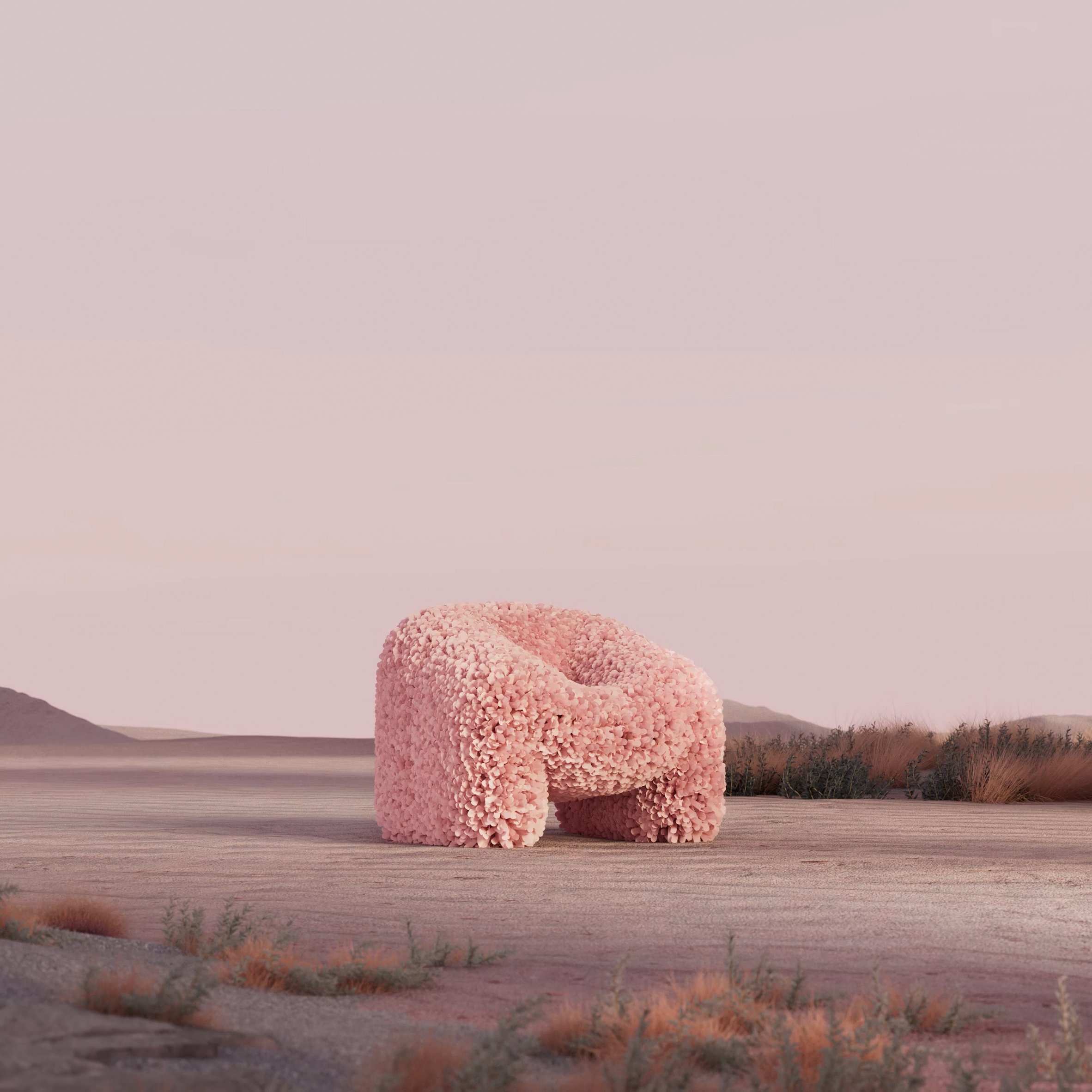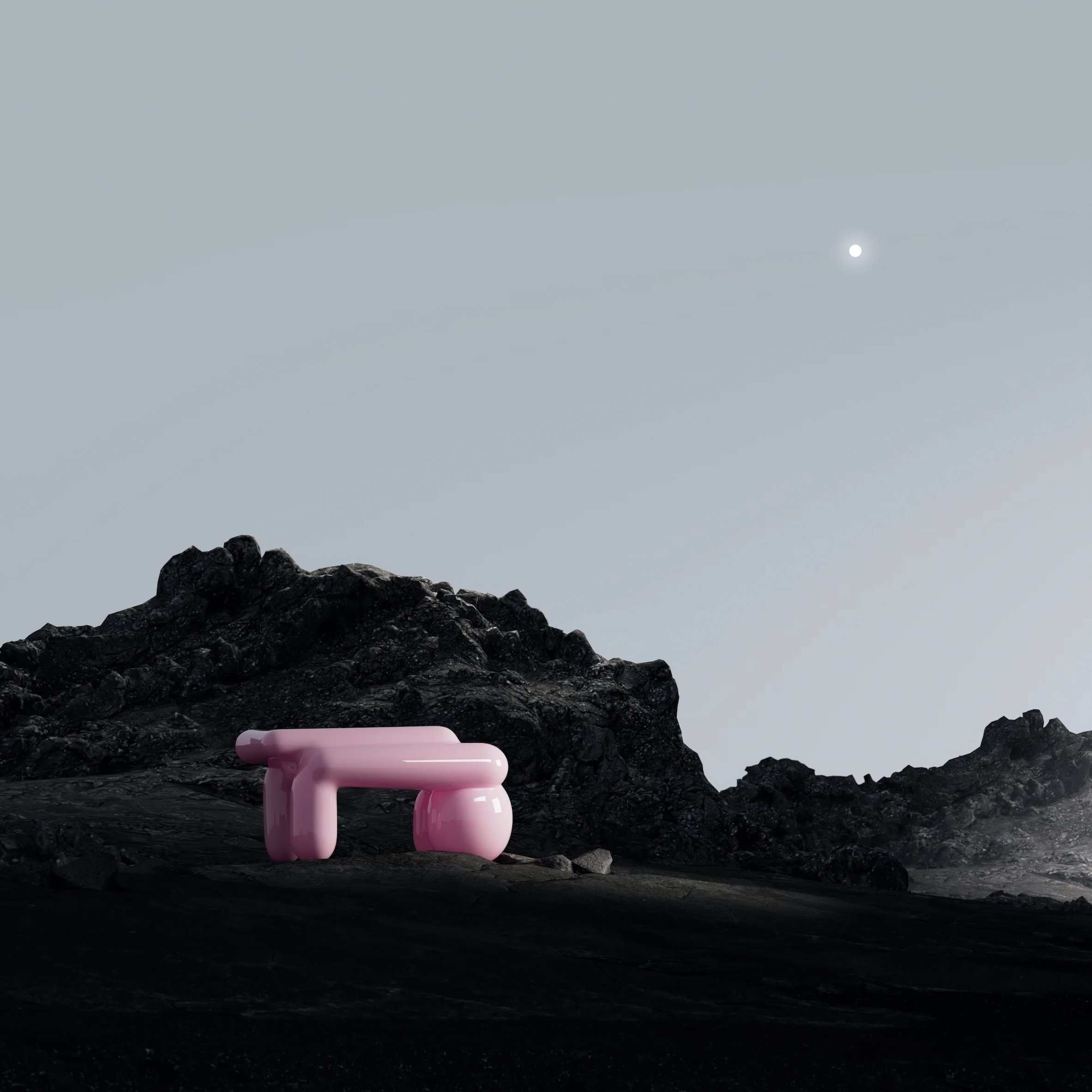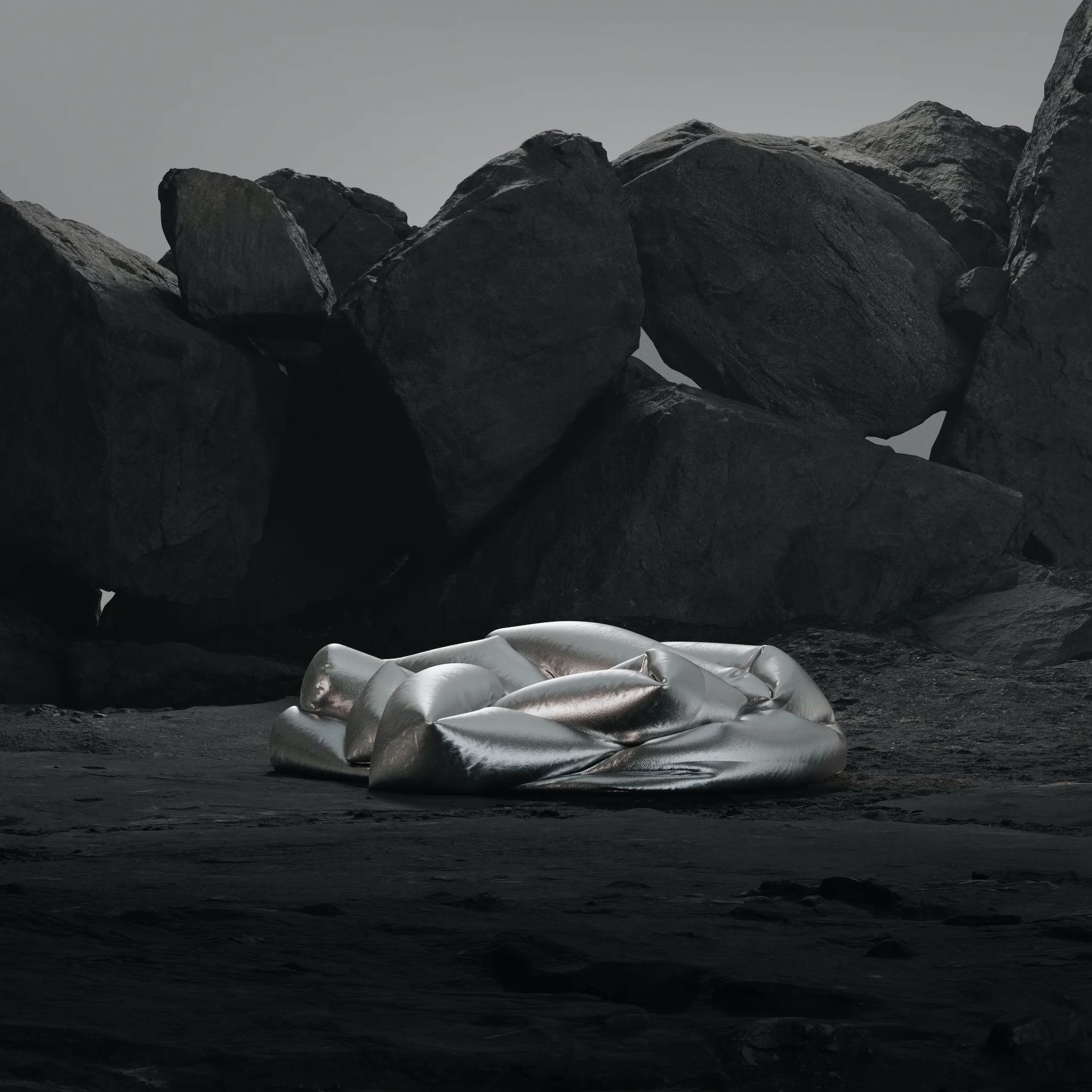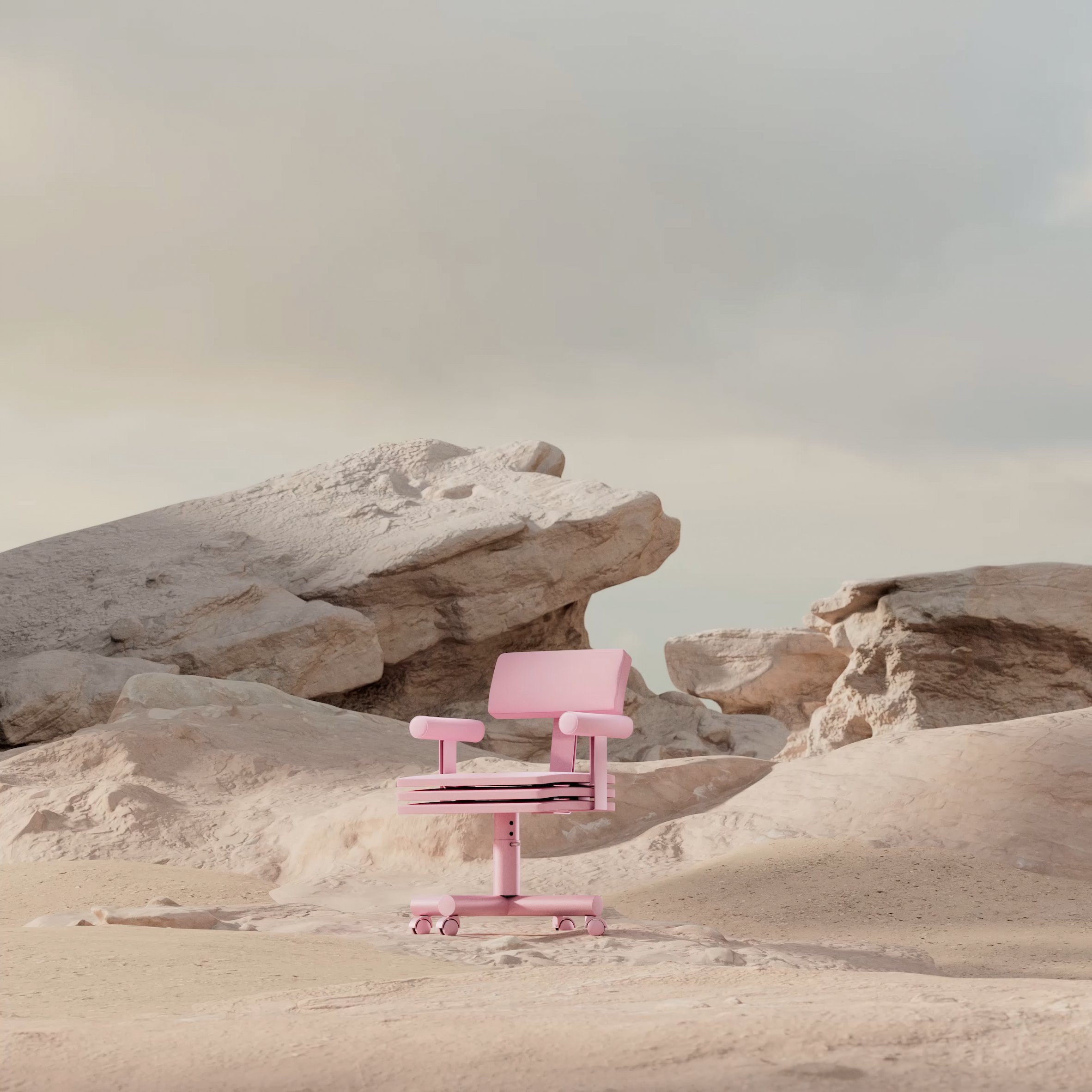Take an E-seat
The Hortensia armchair, originally designed by Andrés Reisinger as a digital file, now also exists as a physical piece produced by Moooi. (image: courtesy of Studio Reisinger).
In February 2021, the designer Andrés Reisinger sold 10 pieces of virtual furniture as non-fungible tokens (NFTs). The pieces, part of a collection named The Shipping, fetched $450,000 on the digital art auction site Nifty Gateway.
To those interested in furniture design, the sale felt like the surreal culmination of a year in which digital has come to dominate our lives in previously inconceivable ways. Artists and designers, in particular, have been forced to reconsider their options for reaching prospective customers. In recent months it has been difficult to avoid news of record-breaking “firsts” of NFTs issued for design, architecture and art projects. A few weeks after Reisinger sold his digital collection, auction house Christie’s announced the sale of a digital collage by the artist Beeple (Mike Winkleman) for almost $70m. The single-lot sale, Christie’s boasted, marked “the first time a purely digital work of art, also known as a Non-Fungible Token (NFT), has ever been offered by a major auction house.” Following Beeple’s record-breaking sale for digital art, the artist Krista Kim sold her Mars House for over half a million dollars on the online marketplace SuperRare, which described the sale as the world’s first of a digital house verified by NFTs.
An NFT is an authentication certificate that is stored on a blockchain, a type of digital ledger that is best known as the enabler of cryptocurrencies. While Bitcoin has become the proto-example among cryptocurrencies, the currency that is most frequently exchanged for NFTs is Ethereum. Since its creation in 2015 and decline in the late 2010s, it has built renewed momentum this past year: from being valued at less than $100 in March 2020, Ethereum hit a high of more than $2,700 in April 2021, with some analysis suggesting this might rise as high as $5,000 by the end of the year. While this rise has been largely driven by the cryptocurrency’s role in decentralised finance, it is Ethereum’s appearance within an art and design context that has brought it to mainstream public attention. With the cancellation of art and design fairs, as well as physical auctions, the sale of NFTs have proven a reliable route to reaching a wider audience when even access to physical artworks have had to be mediated digitally. Christie’s, for instance, counted 22 million participants during the final moments of the Beeple sale.
While some art forms seem well suited to be experienced in a digital format, furniture is a more challenging proposition – to state the obvious, its key function is to be physically used. The chairs we sit on, the desks we work at, the cupboards we store things in, the lamps we read by: while this transactional relationship is far from the only function furniture fulfils, it is the most common, even when furniture is sold at high prices at auction or via design galleries. Even Marc Newson’s Lockheed Lounge (the current record holder for the most expensive furniture object sold by a living designer at £2.4m) can be used for reclining – however tentatively one might choose to do so.
So what exactly is The Shipping? According to the auction’s page on Nifty Gateway, it is “a manifestation of a new hybrid reality” between the virtual and physical. The collection contains 10 pieces of furniture, five of which come with real-world counterparts, while all 10 “can be implemented digitally in any open-world” (an online platform or game that lets you integrate your own digital swag). Some of Reisinger’s designs are unique, while others have been issued in editions of two to five – it’s here that NFTs become crucial in authenticating the specific files, enabling the new owner the possibility of re-selling the work in the future.
Most of Reisinger’s designs suggest sitting or reclining, but there is also a drawer unit and a table. Many pieces are blob-like, sometimes inflatable, and often rendered in pastel pink or chrome. The most conventional pieces are the ABBA desk chair on castors and the Time Table – a wafer-thin sheet material forming a counter-levered tabletop, which is supported on a sphere akin to an exercise ball. The furniture is displayed (exists?) in artfully executed natural landscapes that feature rock formations or deserts, with the light suggesting perpetual dusk, just as the sun has set below the horizon. It’s a seductive, peaceful scene, where the surface of a body of water softly ripples or grass gently sways. To make up for the lack of physical interaction, the furniture performs continuous little dances such as inflating and deflating, gently wobbling, or taking flight like helium-filled balloons. It’s mesmerising to watch, but the real-world counterparts might create some disappointment as a result. What do you mean this sofa doesn’t float?
A few weeks after The Shipping sale, another, non-NFT related sale was announced: the takeover of Dezeen by the Danish media company JP/Politiken Media Group. After 15 years of building a successful online platform dedicated to covering design and architecture, Dezeen’s owners, Marcus Fairs and Rupinder Bhogal, accepted the offer of a buy-out. While the two events are not directly connected, it is tempting to see them in the context of one another. Over the course of its history, Dezeen has usefully traced the narrative arc for how design renders have gone from being a tool in project development to finished products in themselves.
Founded in 2006, Dezeen began life with Fairs republishing the content of press releases about new design launches and events. Accompanying this content was a type of image that had previously been little utilised in design and architecture publishing – the digital render. At this time, renders had been enabled by new and improved digital image-making software, and they quickly became a popular and inexpensive tool for communicating how something not yet produced, and therefore not yet photographed, would look. Design journalists often received these renders ahead of large events such as Milan’s Salone del Mobile: a move that allowed manufacturers, working up to the last minute to produce furniture for the fair, to publicise and drum up interest in their new products before they actually existed. Real-world photographs of the design would appear weeks, sometimes months, after the physical events.
As anyone who has ever tried to photograph furniture in a studio knows, it’s a logistical nightmare and a costly one at that. While social media channels such as Instagram and TikTok have allowed for leaner, on-the-go production of images, in 2006 it was largely down to renders to facilitate the fast communication and spread of new releases. And as Dezeen produced none of its own imagery, the digital render became a prominent feature on its site, with Dezeen’s reputation for fast design-related news seeing audiences grow exponentially. According to its latest annual roundup, Dezeen counted 32.1 million unique users and 110m page views in 2020.
With a generation of aspiring designers and architects having grown up on the site’s fast design news, it’s worth considering how the rendered image has influenced their thinking and approach to design. In the 15-year period since Dezeen’s launch, the rendering has moved from being mere representation, to trading on its own artistic merit. Many brands now use renders for their final marketing campaigns, for instance. Kettal’s recently launched Pavilion O office system was publicised with animated renders created by Reisinger, while in 2020 Field Tiles launched a collection of its tiles with rendered interiors by CGI designer Stefano Giacomello. “Our products are made with respect to craft and heritage, adding a sense of depth and time to each space where they are installed,” explained the brand’s founder Alex Bertman, seemingly seeing no oddity in illustrating this ethos through entirely computer-generated spaces.
Meanwhile, a large number of brands have pushed ever further in their use of hyperreal renders to publicise news, meaning that a quick glance at Dezeen’s paid-for ‘Showroom’ pages can feel like a game of “Digital or physical?” Playing with this ambiguity, some studios have worked on bringing the airbrushed aesthetic of the render into real life, as seen in Wang & Söderström’s collection of objects for Hay, which aspire to a computer-rendered bulbous aesthetic that “manifests the intersection of the digital and physical process”. New York-based studio Jumbo similarly trades on a digital aesthetic for physical forms, most recently with its Creature Comfort Collection which “[explores] the tension between the physical and the digital, the real and the surreal.”
Placing The Shipping collection within this wider storyline makes its sale less surprising: it’s a moment that has been in the making for close to two decades. Reisinger himself sees the development as a positive one for the individual artist, given that it cuts out middlemen such as brands or galleries. “[We] have replaced these institutions with code,” Reisinger told Dezeen after the sale, explaining the digital authentication enabled by NFTs. Another benefit with this system is that the originator of the work can continue to profit from future sales of the same work: the NFTs can be programmed such that a percentage of the profit from any sale will always accrue to the artist in the form of royalties. “I am the first to do it and I hope that it opens the doors to many other artists and designers,” Reisinger explained. “This is a new way, a complementary way to continue growing our careers and businesses.”
In contrast to the hype, the huge environmental impact of this industry, resulting from the intense energy usage involved in mining cryptocurrencies, is in the process of being uncovered: estimates suggest that cryptocurrencies currently account for 0.5 per cent of the world’s total electricity usage. As crypto mining is the basis for all NFT exchanges, trading artworks as NFTs is inextricably entwined with this energy usage, and as a result some artists have even refused to engage with the NFT art market. Architect Chris Precht recently withdrew his work from a sale involving NFTs, stating on his Instagram account: “To [mint] one token through the blockchain equals the same amount of electricity I usually use in one month.” Science magazine Quartz offers a handy, illustrated guide to the environmental impact of selling artworks verified by NFTs, concluding that “over its lifecycle, the average NFT will accrue a stunning footprint of 211kg of CO2, equivalent to driving 513 [miles] in a typical US gasoline-powered car.”
These concerns aside, there is another troubling aspect inherent in the upswing in popularity of digitally rendered design landscapes. Despite the, literally, limitless possibilities available when physical constraints such as material choices and limits of manufacturing technology no longer have to be taken into consideration, these renders are all uncannily similar, to the point of looking interchangeable. These works feature entirely de-populated worlds, coloured in saccharine tones, where the weather seems to never vary from a gentle breeze and hazy sunshine. The term “AirSpace” was coined by the writer Kyle Chayka to describe the type of gentrified environments that have grown out of an economy catering for global consumers looking for the same type of hotels, coffee shops and restaurants, whether they are in Tokyo, Sydney or San Francisco. “The connective emotional grid of social media platforms is what drives the impression of AirSpace,” he wrote. “If taste is globalized, then the logical endpoint is a world in which aesthetic diversity decreases.” It seems that the digital realm of designed environments suffers from the same homogeneity, which is somewhat disappointing considering the possibilities at hand.
This became apparent when one of the pieces in The Shipping sale, the Hortensia armchair, recently launched as a physical product manufactured by the Dutch furniture brand Moooi. The squat and boxy armchair is covered in a highly textured fabric made to look like thousands of pink flower petals – hence the name (hydrangea in English). Moooi’s imagery shows the chair in the seductive CGI environment of a Roman ruin, but removed from this context it loses something of its appeal. Without the breeze moving through the petals and that soft, otherworldly light enhancing its features, you are forced to engage with it as a piece of actual furniture fulfilling the task of seating. As such the design seems less intriguing, its material choice impractical and unnecessarily frivolous. With rendering having come full-circle – from having served as a representation, to becoming the actual work, to inspiring the physical representation – it seems legitimate to ask how renders may meaningfully shape furniture design in the future. From the examples currently presented, it seems the answer is some way off.
Words Johanna Agerman Ross
Images Studio Reisinger
This article was originally published in Disegno #29. To buy the issue, or subscribe to the journal, please visit the online shop.
The physical version of the Hortensia armchair is available from Moooi, price on request.






